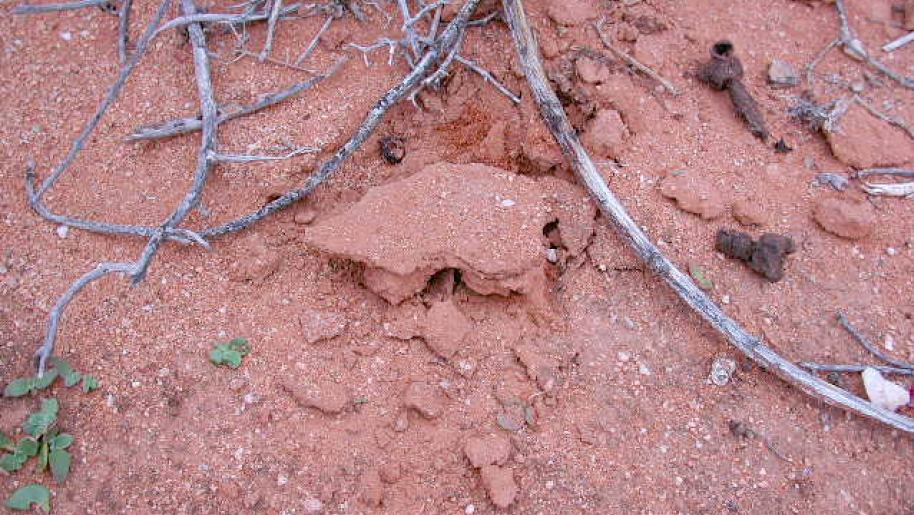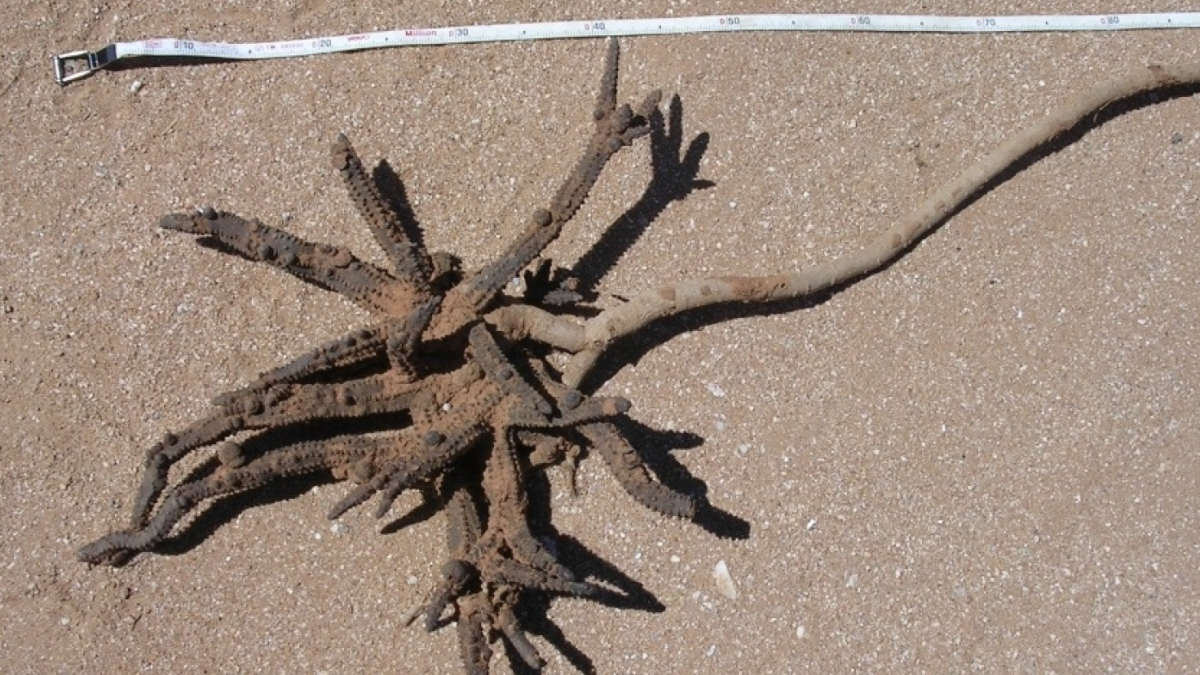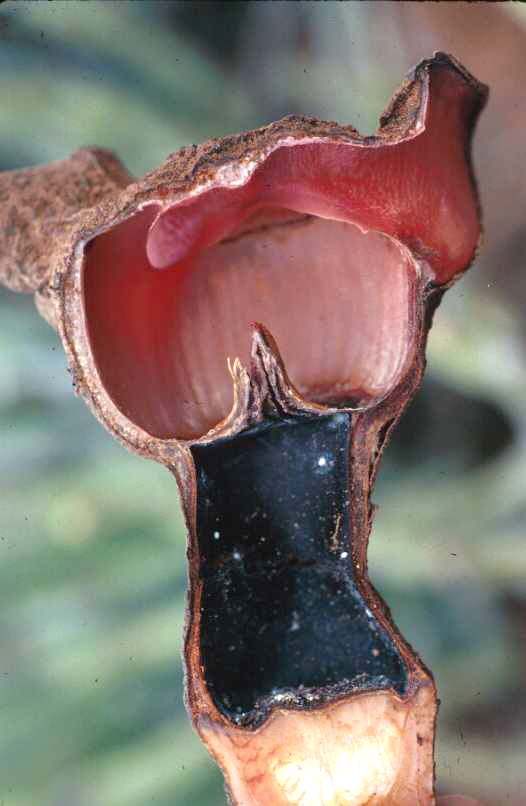Then God said, “Let the land produce vegetation: seed-bearing plants and trees on the land that bear fruit with seed in it, according to their various kinds.” And it was so. The land produced vegetation: plants bearing seed according to their kinds and trees bearing fruit with seed in it according to their kinds. And God saw that it was good. —Gen. 1:11–12
If I asked you to imagine a plant, most likely you’d picture something with stems, roots, and green leaves. Perhaps a potted plant, a garden, or a tree.
Now imagine a plant with neither stems nor leaves, living entirely underground. Such a creature is my candidate for the strangest plant in the world: Hydnora triceps, a species so rare and poorly known that it has no accepted English common name. From its remote location, to its hidden nature, to its stealthy means of pollination, this is the weirdest member of an odd group.
A Parasitic Plant, an Ancient Desert
Like other plants in the African genus Hydnora, this species is a parasite that depends entirely upon its host for water and nutrients. The idea of plant cannibalism is counterintuitive—one of the first things we learn about plants in school is that they produce their own food. But many get their water or nutrients by boring into other plants through specialized roots. While all parasites take food from their hosts, these plants feed on other plants.
Mistletoe, that icon of holiday love, is a well-known parasite, feeding on whatever tree or shrub it it is attached to. But mistletoe still contains chlorophyll and can produce food from the sun through photosynthesis. Hydnora species lack chlorophyll and are the only known angiosperms (flowering plants) without leaves. Spending their whole lives buried in the desert soil, they only emerge from the netherworld to flower. What makes H. triceps unique is that it doesn’t surface from the ground to flower. It flowers and develops its fruits underground.
The plant grows in one of the most interesting plant communities in the world, the Namib Desert—a narrow strip of sand and gravel along the west coast of Namibia and northwestern South Africa. It is perhaps the oldest desert in the world, containing many plants that grow nowhere else. Hydnora triceps is restricted to a small area of this biome. Rainfall is sparse (as low as 2 millimeters per year) and wildly unpredictable. A frequent fog provides the modicum of life-sustaining moisture in this severe desert. Shrubby members of the genus Euphorbia—distant relatives of the Christmas poinsettia—are the keystone species here. Stiff, erect leafless stems intercept the fog, collecting the mist that then drips down the stems to the thirsty roots. Those roots serve as Hydnora’s hosts.
Digging Up a Lost Species
I studied Hydnora in Sudan and southern Africa for many years, but I was never able to locate H. triceps. I thought I never would; few have. This enigmatic plant was first described in 1830 by the German Huguenot and plant collector Johann Dregé. For more than a century and a half after, it remained unstudied, until, in the 1980s, my friend and colleague Johann Visser of Stellenbosch University uncovered one. Understandably excited, Visser sent me photographs and invited me to join him in the Northern Cape Province to share his find. Tragically, he died shortly after reporting this news. But not before he explained the reason the plant was so rare: because, as he found, it flowered underground! Subsoil flowering is unknown except for a very rare orchid of Western Australia that acts as a fungus. I had to follow up on his discovery and see H. triceps for myself.
On a cold, foggy early spring day (September in the southern hemisphere), I joined South African botanists as we located this elusive plant’s only known host, named Euphorbia dregeana after Dregé. Now we had to find the parasite. How could we locate the underground treasure? Two ways. First, by the smell. The mature flowers have an overpowering, nauseating odor of decaying animals—disgusting to humans but attractive to the carrion-eating insects that enter the flower through cracks in the desert pavement, tricked into thinking they have found a food source. The second guide to the plants is the cracked soil caused by the expansion of the flowers and fruits.
Triceps Propagation: It’s a Trap—and Jackals Help
H. triceps has a remarkable system of trapping its insect visitors and exploiting them for pollination. When the flower opens, the plant is in the female phase. The flower has a chamber that the insects enter before dropping to the female portion. The wall of the chamber is smooth, providing no traction for the trapped insect to escape. In the meantime, a ring above the female part closes and imprisons the insect overnight while at the same time releasing pollen. The next day the ring opens and the wall of the chamber roughens so the insects can climb out—but only after receiving a dusting of pollen. The insects fly to the female part of the next flower, dispensing pollen in the process. The ring closes, the insects are trapped, and the process is repeated.
The fruits of H. triceps were unknown to science until we finally found them in southern Namibia. They are the size and shape of a small grapefruit, brown and scaly on the exterior, white and full of small seeds inside. Would you eat one, knowing of its foul odor and understanding that nutrition is derived from a toxic host? They are actually tasty, with a potato-like starchiness and a hint of sweetness. Locals relish them and call the fruit jakkalskos, or jackal’s food. Jackals have been implicated in the dispersal of seeds from the ingested fruits.
Why the Weirdness?
Why is this plant so strange? Because it lives in such an extreme environment. Being subterranean protects the plant from the relentless heat and aridity as well as grazing by hungry and thirsty animals (though they sometimes dig up the plants).
Amazed by this odd plant, my students and I continue to research Hydnora, and we recently described a new species discovered in Oman. At times I reflect on this work as in part following in the footsteps of the wisest man who ever lived. Solomon was a botany professor (in that he professed botany) known for his work describing plants. “He spoke about plant life, from the cedar of Lebanon to the hyssop that grows out of walls,” 1 Kings 4:33 records—suggesting that he wasn’t just interested in the species’ appearance or usefulness, but in their ecology and distribution. I think Solomon was enthusiastic about plants and (like me) rejoiced in seeing their diversity in form, function, utility, and oddity. And like him, I am constantly reminded of the Creator’s hand, ingenuity, and art when I work with plants. Especially weird ones.





Lytton John Musselman is the Mary Payne Hogan Professor of Botany at Old Dominion University and author of A Dictionary of Bible Plants (Cambridge University Press, 2011).















